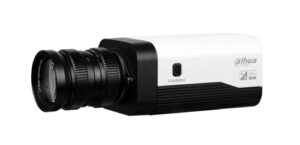 This is an 8MP (UHD) box style camera with very high sensitivity and intelligent video detection capabilities. It is promoted as a Starlight+ camera. For the purposes of testing it was supplied with a 12MP rated 8.5mm fixed focal length manual iris lens.
This is an 8MP (UHD) box style camera with very high sensitivity and intelligent video detection capabilities. It is promoted as a Starlight+ camera. For the purposes of testing it was supplied with a 12MP rated 8.5mm fixed focal length manual iris lens.
The most significant difference noted is that due to the large format of the CMOS sensor used, the lens mount is an M43 (Micro four thirds) bayonet-style connection rather than the familiar C or CS CCTV standard. The four thirds in the mount type describes the 4/3” sensor type which has a diagonal measurement of 21.6mm. Sensor sizes are still related to the original diameter of thermionic tube devices so do not follow the convention used for display screens.
The casing has one top and two base located ¼” Whitworth thread mounting holes. Power is less than 10.5W PoE or alternatively by 12v DC or 24v AC supply. Edge storage can be installed with a Micro SD card of up to 128GB.
Getting started
With the camera connected to a suitable PoE network point and the lens fitted it is necessary to log in to the camera for setting up. DHCP is not enabled by default. The quick start guide advises that you use “ConfigTools.exe” from the supplied CD to identify the camera’s IP address. Unfortunately the file was supplied as a compressed file titled: General_Config_Tool_Eng_V.4.00.0.R.160310.7z.
From a security perspective, it is not good to have files supplied that utilise a non-standard compression format that depends on freeware from the web. When extracted and run the Configuration Tool was found to be very disappointing; the “Publisher unknown” message does not give confidence and then the lack of any reference to Dahua within the programme or in the 27-page Operation Manual suggest that this is a third-party late inclusion. The actual operation was found to be quite poor as it only detects cameras on the PCs subnet rather than full discovery although this is stated in the quick-start documentation. It is also necessary to state the start and end IP addresses to be scanned via a Setting window that is not immediately obvious when the program is first run.
Once connected via a Windows browser the full camera settings are accessible, though there is initially no live image capability. The Live window prompts for a link to “install the plug-in”. On IE on a Windows 8 or 10 PC this loads promptly, but for Edge on a Windows 10 PC the link takes you to a Google App Store Chrome NACL (Native Client) page from where you can run the NACL app. This opens a Web Service browser from where you can reselect the IP address and after re-entering the log-in details gives full access to the video image and settings options. No detail on this process was provided or available via the Dahua website support area but with patience it is possible to add a direct NACL Web Plug-in icon to the desktop and this operated well.
The camera supports ONVIF protocols but best results would likely be obtained with a Dahua NVR or VMS.
Performance
The camera gives a very high-resolution image and has high sensitivity. Specification data for sensitivity is not very helpful as it is quoted as being a minimum light level of 0.0005 Lux colour, though this is based on a lens of F0.95 rather than the F2.8 provided and using a shutter speed of 1/3 second which gives a fair amount of motion blur. 1/30th of a second figure is given as 0.003 Lux colour and 0.002 Lux B&W. However, the actual sensitivity is impressive if care is taken to set the camera for the scene conditions and works well below the human eye’s ability to resolve objects in the dark.
Read the full test report in the February 2018 edition of PSI magazine

